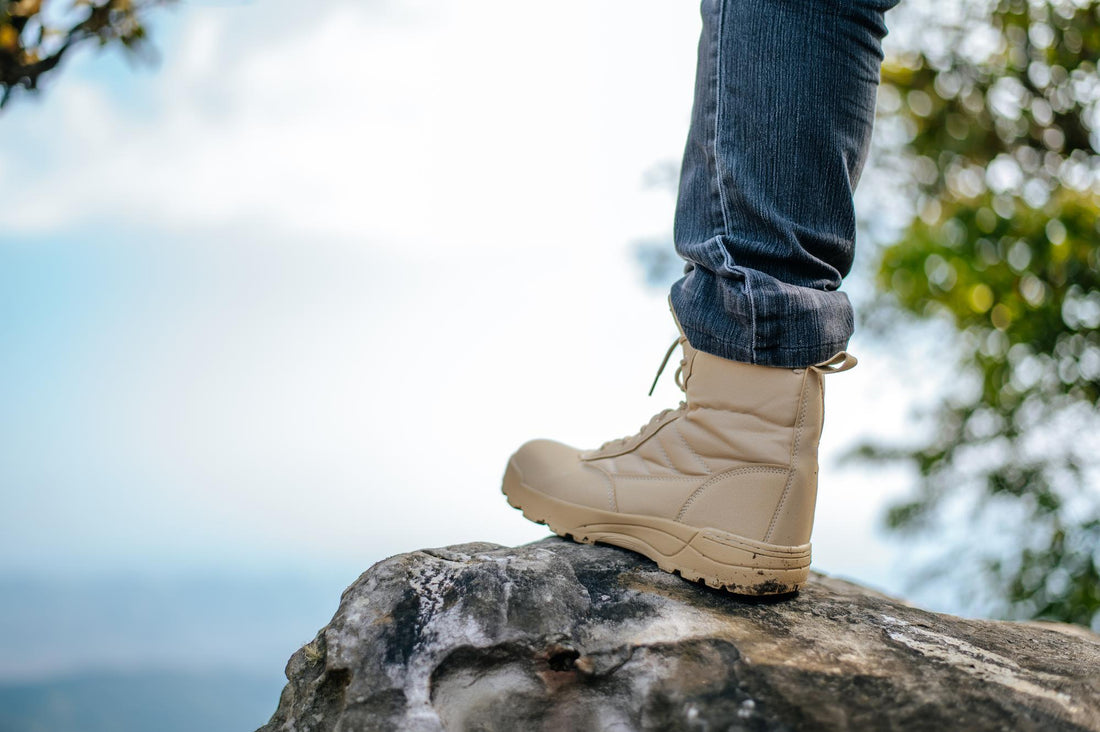
Should You Team Up Socks with Your Climbing Shoes?
Share
Introduction
The climbing community often finds itself embroiled in a variety of debates, but one that persistently resurfaces is the question of whether to wear socks with climbing shoes. This seemingly minor choice is actually layered with considerations regarding comfort, performance, hygiene, and tradition. Unraveling this debate requires an understanding of both sides, examining the practical implications of wearing socks in climbing shoes and the evolution of climbing footwear itself. As we delve into this topic, it's important to keep an open mind and consider how personal preference, climbing discipline, and the type of climbing shoe all play a role in this decision.
Quick Insight To Sock or Not to Sock in Climbing?
The choice between wearing socks or going sockless in climbing shoes is often influenced by a climber's priorities and the specific context of their climbing activity. On one hand, going sockless is argued to offer better sensitivity and a more precise fit, crucial for technical climbs where feeling the rock is paramount. On the other hand, wearing socks can increase comfort, reduce the risk of blisters, and improve hygiene by absorbing sweat and reducing odor. Climbers must weigh these factors against their personal preferences and the demands of their climbing pursuits to make the best choice for their feet.

The Journey of Climbing Footwear and Socks
Climbing Shoes and Socks Over the Years
The relationship between climbing footwear and socks has evolved significantly since the early days of the sport. Originally, climbers wore heavy boots, often with socks for additional warmth and protection. As climbing techniques and equipment progressed, the introduction of specialized climbing shoes revolutionized the sport. These shoes, designed to fit snugly and made with sticky rubber soles for superior grip, changed climbers' approach to footwear. Initially, climbers continued wearing socks with these new shoes for comfort and to fill out larger sizes, as the shoes were not as precisely fitted as they are today.
Over the years, as climbing shoes became more advanced and tailored to different types of climbing, the practice of wearing socks with climbing shoes became less common. Manufacturers began offering a wide range of sizes and styles, allowing climbers to find shoes that fit closely to their bare feet, maximizing sensitivity and precision on the rock. Today, the choice to wear socks with climbing shoes is largely a personal preference, influenced by the type of climbing, the specific shoe design, and the climber's own comfort and performance needs.
The debate over whether to wear socks in climbing shoes reflects broader themes in climbing culture, including innovation, tradition, and personalization of gear. As climbing continues to evolve, so too will climbers' preferences and practices regarding their footwear, making this an ongoing conversation within the climbing community.
When to Slip Socks into Climbing Shoes
The traditional image of a climber might not include socks with their climbing shoes, but there are compelling reasons to consider this combination. Socks can offer additional cushioning, reduce the risk of blisters, and improve hygiene, especially when using rental shoes or sharing footwear. For climbers with sensitive skin or those prone to foot problems, socks act as a protective barrier between the foot and the shoe, potentially enhancing comfort during long climbs. Furthermore, socks can slightly alter the fit of a climbing shoe, offering a solution for those in-between sizes or those with uniquely shaped feet.
The Necessity of Socks in Rental Climbing Footwear
When it comes to rental climbing shoes, wearing socks is almost a necessity rather than a choice. Rentals, worn by many people, can be a breeding ground for bacteria and fungi. Socks provide a hygienic layer that can protect against athlete's foot and other skin conditions. They also help in maintaining personal comfort and hygiene, ensuring that the focus remains on climbing performance and enjoyment, rather than worrying about the cleanliness of the shoes.
Tackling the Challenge of Hyperhidrosis (Excessive Sweating)
For climbers with hyperhidrosis, or excessive sweating, managing foot moisture is crucial. Moisture inside the shoe can lead to slipping, decreased performance, and a higher risk of fungal infections. Wearing moisture-wicking socks can significantly mitigate these issues by absorbing sweat and keeping the feet dry. This not only improves grip within the shoe but also extends the footwear's lifespan by preventing the breakdown of materials caused by constant moisture.
Navigating Big Wall and Crack Climbing with Socks
Big wall and crack climbing present unique challenges that can make the case for wearing socks even stronger. These climbing forms often require jamming feet into cracks or spending extended periods in climbing shoes, which can lead to increased friction and discomfort. Socks can reduce friction, protect the skin from abrasions, and provide a layer of cushioning that can make the difference during long, challenging climbs. They can also offer slight thermal insulation on colder days, keeping climbers' feet warmer and more comfortable.
Embracing Personal Comfort and Choice
Ultimately, the decision to wear socks with climbing shoes boils down to personal comfort and choice. While traditionalists may eschew socks for a closer shoe-to-rock feel, many climbers find that the benefits of wearing socks—such as improved hygiene, comfort, and protection—outweigh any potential drawbacks. As climbing evolves, so do climbers' approaches to gear and apparel, with an increasing number embracing socks as a viable option for enhancing their climbing experience. Experimentation and personal preference should guide climbers in finding the setup that works best for them, ensuring that their focus remains on the climb ahead.

The Advantages and Drawbacks of Climbing with Socks
Climbers often find themselves at a crossroads when deciding whether to wear socks with their climbing shoes. This choice is not merely about personal comfort; it encompasses a range of factors that can affect performance, foot health, and overall climbing experience. Understanding the advantages and drawbacks of climbing with socks is crucial for making an informed decision that aligns with individual needs and preferences.
The Upsides of Choosing Socks for Climbing
Wearing socks with climbing shoes offers several benefits. Firstly, socks act as a barrier between the foot and the shoe, reducing friction and the likelihood of developing blisters or hotspots during prolonged climbing sessions. This can be particularly advantageous for climbers engaging in long multi-pitch routes where foot comfort becomes paramount. Secondly, socks absorb sweat, keeping the feet drier and more comfortable while also helping to maintain a better hygiene level inside the shoe. This absorption can mitigate the growth of bacteria and fungi, often the culprits behind unpleasant odors. Lastly, for climbers who find themselves between shoe sizes, socks can provide a snugger fit, ensuring that the shoes are securely attached to the feet without any unwanted movement that could compromise precision and performance.
Considering the Compromises
However, climbing with socks also introduces certain compromises. The primary concern is the potential loss of sensitivity. The thin layer of fabric, although seemingly negligible, can dull the connection between the foot and the rock, making it harder for climbers to feel small or subtle features that could be crucial for successful ascents. This reduced sensitivity might not significantly impact beginners or those climbing on less technical routes, but for advanced climbers tackling challenging problems, it could be a decisive factor. Additionally, wearing socks can alter the fit of the climbing shoe, especially if the shoes were designed and sized for barefoot use. This altered fit might lead to less precision in foot placements and could affect the overall performance.
Selecting Your Climbing Sock Squad
Choosing the right socks for climbing involves considering several factors, including material, thickness, and fit. The ideal climbing sock should be thin enough to preserve shoe sensitivity while being capable of wicking moisture away from the skin. It should also fit snugly, without bunching or sliding, to avoid creating pressure points or interfering with the shoe's fit.
The Ultimate Climbing Socks Guide
When it comes to selecting socks for climbing, there are several types to consider. Merino wool socks are a popular choice due to their natural moisture-wicking and odor-resistant properties, offering a good balance between comfort and performance. Synthetic blends, often featuring materials like polyester and nylon, provide excellent durability and quick-drying capabilities, making them suitable for climbers who prioritize moisture management.
Multi-Sport Ultra-Light Socks for Climbers
For climbers looking for versatile options, multi-sport ultra-light socks present an appealing choice. These socks are designed to provide minimal insulation and maximum breathability, making them ideal for indoor climbing or warm-weather outdoor adventures. Their ultra-light construction ensures that sensitivity is preserved as much as possible, while still offering the benefits of reduced friction and improved hygiene. When selecting such socks, climbers should focus on models that offer a tight, seamless fit to avoid any discomfort or interference with the climbing shoe's performance.

Conclusion
In conclusion, the decision to wear socks while climbing is a personal one, influenced by various factors including the type of climbing, personal comfort preferences, and the specific characteristics of the climbing shoes. By carefully considering the advantages and drawbacks, and selecting the appropriate socks, climbers can enhance their climbing experience without significantly compromising performance.
